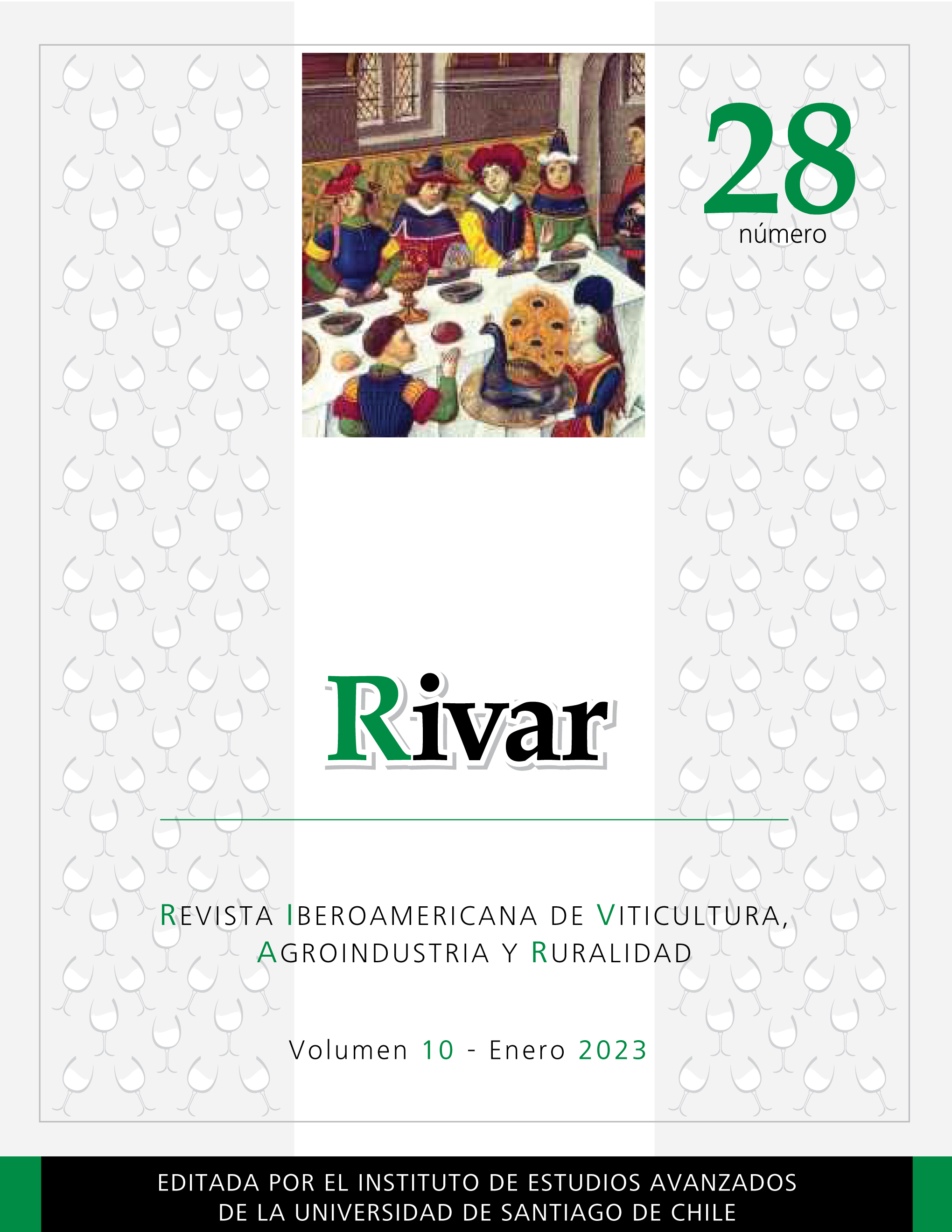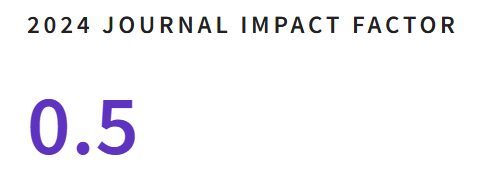Estudio espacializado del decaimiento de la vid en cuarteles Cabernet Sauvignon y Chardonnay
DOI:
https://doi.org/10.35588/rivar.v10i28.5027Palabras clave:
enfermedades de la madera, dispersión espacial radial, poda en cargadores, poda en pitones, viticulturaResumen
Las enfermedades fúngicas de la madera de la vid (EMVs) están entre los problemas fitosanitarios más dañinos en la industria vitivinícola; entre los principales síntomas observados en campo destaca una reducción drástica de la productividad, calidad y longevidad de los viñedos. Determinamos la distribución espacial y la incidencia y severidad del decaimiento por Botryosphaeria en cinco cuarteles Cabernet Sauvignon y tres de Chardonnay podadas pitón y cargador, respectivamente. Las mediciones se efectuaron planta por planta y cada punto de muestreo fue georreferenciado usando un DGPS. Por otro lado, se determinó el potencial de xilema de las vides en tres mediciones durante la temporada. El decaimiento de la vid presentó una importante variabilidad a nivel intra-predial en Cabernet Sauvignon y la severidad se expresa de forma radial; la incidencia de la enfermedad en Chardonnay tendió a encontrarse hacia un lado de los cuarteles. A su vez, la incidencia y la severidad de la enfermedad fue mayor en los cuarteles Cabernet Sauvignon que en los de Chardonnay (43% y 13% de plantas afectadas, respectivamente). De acuerdo con el potencial de xilema, las vides Cabernet Sauvignon estuvieron sometidas a mayor nivel de estrés hídrico que las vides Chardonnay a lo largo del estudio. Es posible sugerir que existe una respuesta varietal a la enfermedad y que la poda y el estrés hídrico pueden aumentar la susceptibilidad de las vides a las enfermedades de la madera asociadas a especies de la familia Botryosphaeriaceae.
Descargas
Referencias
Acevedo-Opazo, C.; Valdés-Gómez, H.; Taylor, J. A., Avalo, A., Verdugo-Vásquez, N., Araya, M., Jara-Rojas, F. y Tisseyre, B. (2013). “Assessment of an Empirical Spatial Prediction Model of Vine Water Status for Irrigation Management in a Grapevine Field”. Agricultural Water Management 124: 58-68. DOI https://doi.org/10.1016/j.agwat.2013.03.018
Agustí-Brisach, C.; León, M.; García-Jiménez, J. y Armengol J. (2015). “Detection of Grapevine Fungal Trunk Pathogens on Pruning Shears and Evaluation of their Potential for Spread of Infection”. Plant Disease 99: 976-981. DOI https://doi.org/10.1094/PDIS-12-14-1283-RE
Bertsch, C.; Ramírez-Suero, M.; Magnin-Robert, M.; Larignon, P.; Chong, J.; Abou-Mansour, E.; Spagnolo, A.; Clément, C. y Fontaine, F. (2012). “Grapevine Trunk Diseases: Complex and Still Poorly Understood”. Plant Pathology 62(2): 243-265. DOI https://doi.org/10.1111/j.1365-3059.2012.02674.x
Chacón-Vozmediano, J.L.; Gramaje, D.; León, M.; Armengol, J.; Moral, J.; Izquierdo-Cañas, P.M. y Martínez-Gascueña, J. (2021). “Cultivar Susceptibility to Natural Infections Caused by Fungal Grapevine Trunk Pathogens in La Mancha Designation of Origin (Spain)”. Plants 10: 1171. DOI https://doi.org/10.3390/plants10061171
Cholet, C.; Bruez, É.; Lecomte, P.; Barsacq, A.; Martignon, T.; Giudici, M.; Simonit, M.; Rey, P.; Dubourdieu, D. y Gény, L. (2021). “Plant Resilience and Physiological Modifications Induced by Curettage of Esca-Diseased Grapevines”. OENO One 55(1): 153-169. DOI https://doi.org/10.20870/oeno-one.2021.55.1.4478
Faúndez-López, P.; Delorenzo-Arancibia, J.; Gutiérrez-Gamboa, G. y Moreno-Simunovic, Y. (2021). “Pruning Cuts Affect Wood Necrosis but not the Percentage of Budburst or Shoot Development on Spur Pruned Vines for Different Grapevine Varieties”. Vitis 60: 137-141. DOI https://doi.org/10.5073/vitis.2021.60.137-141
Fontaine, F.; Pinto, C.; Vallet, J.; Clément, C.; Gomes, A.C. y Spagnolo, A. (2015). “The Effects of Grapevine Trunk Diseases (GTDs) on Vine Physiology”. European Journal of Plant Pathology 144(4): 707-721. DOI https://doi.org/10.1007/s10658-015-0770-0
Gramaje, D.; Armengol, J.; Barajas, E.; Berbegal, M.; Chacón-Vozmediano, J.L.; Cibrian, J.; Díaz-Losada, E.; López-Manzanares, B.; Muñoz, R.; Martínez-Diz, M.P.; Rubio, J. y Següés, A. (2020). Guía de enfermedades fúngicas de la madera de la vid. Madrid, Grupo de Trabajo de Experimentación en Viticultura y Enología, Ministerio de Agricultura, Pesca y Alimentación.
Gramaje, D.; Úrbez-Torres, J.R. y Sosnowski, M.R. (2017). “Managing Grapevine Trunk Diseases with Respect to Etiology and Epidemiology: Current Strategies and Future Prospects”. Plant Disease 102(1): 12-39. DOI https://doi.org/10.1094/pdis-04-17-0512-fe
Gutiérrez-Gamboa, G., Pérez-Donoso, A. G., Pou-Mir, A., Acevedo-Opazo, C. y Valdés-Gómez, H. (2019). “Hydric Behaviour and Gas Exchange in Different Grapevine Varieties (Vitis vinifera L.) from the Maule Valley (Chile)”. South African Journal of Enology and Viticulture 40(2): 181-191. DOI https://doi.org/10.21548/40-2-3224
Henderson, B.; Sosnowski, M.R.; McCarthy, M.G. y Scott, E.S. (2021). “Incidence and Severity of Eutypa Dieback in Grapevines are Related to Total Surface Area of Pruning Wounds”. Australian Journal of Grape and Wine Research 27: 87-93. DOI https://doi.org/10.1111/ajgw.12465
Keller, M. (2020). The Science of Grapevines. Tercera edición. Ámsterdam, Elsevier.
Luque, J.; Elena, G.; Garcia-Figueres, F.; Reyes, J.; Barrios, G. y Legorburu, F.J. (2014). “Natural Infections of Pruning Wounds by Fungal Trunk Pathogens in Mature Grapevines in Catalonia (Northeast Spain)”. Australian Journal of Grape and Wine Research 20: 134-143. DOI https://doi.org/10.1111/ajgw.12046
Martínez-Diz, M. del P., Eichmeier, A., Spetik, M., Bujanda, R., Díaz-Fernández, Á., Díaz-Losada, E. y Gramaje, D. (2020). “Grapevine Pruning Time Affects Natural Wound Colonization by Wood-Invading Fungi”. Fungal Ecology 48: 100994. DOI https://doi.org/10.1016/j.funeco.2020.100994
Mondello, V.; Songy, A.; Battiston, E.; Pinto, C.; Coppin, C.; Trotel-Aziz, P.; Clément, C.; Mugnai, L. y Fontaine, F. (2018). “Grapevine Trunk Diseases: A Review of Fifteen Years of Trials for their Control with Chemicals and Biocontrol Agents”. Plant Disease 102(7): 1189-1217. DOI https://doi.org/10.1094/pdis-08-17-1181-fe
Mostert, L.; Groenewald, J.Z.; Summerbell, R.C.; Gams, W. y Crous, P.W. (2006). “Taxonomy and Pathology of Togninia (Diaporthales) and its Phaeoacremonium Anamorphs”. Studies in Mycology 54: 1-113. DOI https://doi.org/10.3114/sim.54.1.1
Moyo, P.; Allsopp, E.; Roets, F.; Mostert, L. y Halleen, F. (2014). “Arthropods Vector Grapevine Trunk Disease Pathogens”. Phytopathology 104: 1063-1069. DOI https://doi.org/10.1094/PHYTO-11-13-0303-R
Ortega-Farias, S.; Lozano, P.; Moreno, Y. y Leon, L. (2002). “Desarrollo de modelos predictivos de fenología y evolución de madurez en vid para vino cv. Cabernet Sauvignon y Chardonnay”. Agricultura Técnica 62: 27-37. DOI https://doi.org/10.4067/s0365-28072002000100003
Ouadi, L.; Bruez, E.; Bastien, S.; Vallance, J.; Lecomte, P.; Domec, J.C. y Rey, P. (2019). “Ecophysiological Impacts of Esca, a Devastating Grapevine Trunk Disease on Vitis vinifera L.”. PLOS ONE 14(9): e0222586. DOI https://doi.org/10.1371/journal.pone.0222586
Sosnowski, M.; Luque, J.; Loschiavo, A.; Martos, S.; García-Figueres, F.; Wicks, T.J. y Scott, E.S. (2011). “Studies on the Effect of Water and Temperature Stress on Grapevines Inoculated with Eutypa lata”. Phytopathologia Mediterranea 50: 127-138.
Sosnowski, M.; Ayres, M. y Scott, E. (2020). “The Influence of Water Deficit Stress on the Grapevine Trunk Disease Pathogens”. Eutypa lata and Diplodia seriata. Plant Disease 105: 2217-2221. DOI https://doi.org/10.1094/PDIS-07-20-1538-RE
Verdugo-Vásquez, N.; Acevedo-Opazo, C.; Valdés-Gómez, H.; Araya-Alman, M.; Ingram, B.; García de Cortázar-Atauri, I. y Tisseyre, B. (2016). “Spatial Variability of Phenology in Two Irrigated Grapevine Cultivar Growing under Semi-Arid Conditions”. Precision Agriculture 17(2): 218-245. DOI https://doi.org/10.1007/s11119-015-9418-5
Verdugo-Vásquez, N.; Acevedo-Opazo, C.; Valdés-Gómez, H.; Ingram, B.; García de Cortázar-Atauri, I. y Tisseyre, B. (2018). “Temporal Stability of Within-Field Variability of Total Soluble Solids of Grapevine under Semi-Arid Conditions: A First Step Towards a Spatial Model”. OENO One 52(1): 15-30. DOI https://doi.org/10.20870/oeno-one.2018.52.1.1782









